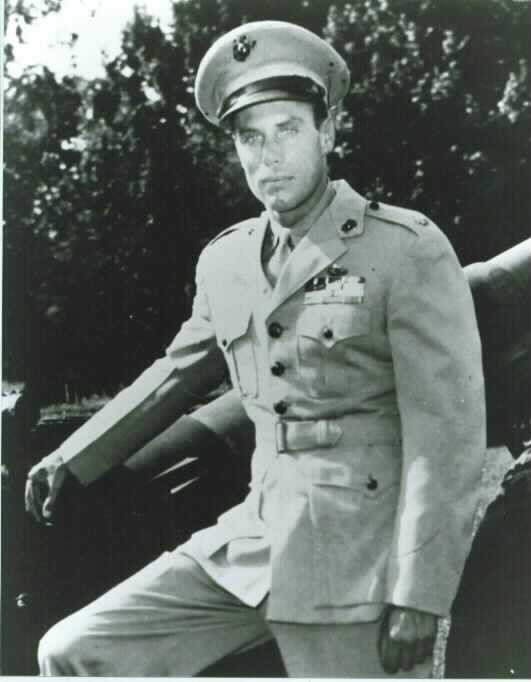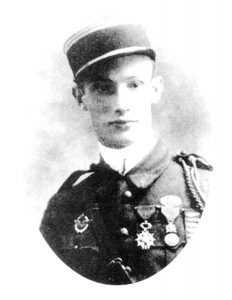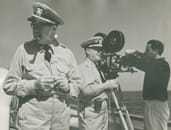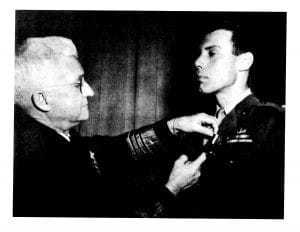Most people would be grateful to experience any one of the occupations listed above—French Foreign Legionnaire, wartime spy, US Marine, or Hollywood heartthrob—but because Pierre (Peter) Julien Ortiz was not “most people,” he chose to immerse himself in all four.
The Legionnaire
The man who would become the most-decorated member of the Office of Strategic Services and one of the most decorated US Marines in World War II was born in New York City in 1913, to a French father who had a strong Spanish background, and an American mother.
The young Peter—once described as “tall, handsome, urbane, and sophisticated”—had many influential connections in French society and was a student in Grenoble when he decided to trade the tranquil life of a college student for something more exciting—a five-year enlistment in the French Foreign Legion (FFL). He enlisted in 1932 in the name of his Polish girlfriend.
Peter rose from private to sergeant and was offered a permanent commission as a second lieutenant—if he would re-enlist for five years and agree to eventually become a naturalized French citizen.
He refused and instead returned to the United States. Peter had, however, made quite the impression—he had fought with the Legion in several engagements in Africa with the indigenous Rif tribesmen, had been wounded in 1933, and came home with a chest full of medals, including two awards of the Croix de Guerre.
Upon his return, he joined his mother in California, serving as a technical advisor for war films until the outbreak of World War II in Europe, which—since the United States was still neutral in 1939—prompted Peter to return to the Legion in October of that year, as a sergeant.

The POW
By May 1940, he had received a battlefield commission but became a POW in June 1940 during the Battle of France when he was wounded while blowing up a fuel dump.
When he learned that some gasoline had not been blown up before the Germans arrived, he commandeered a motorcycle and returned to the area, drove through the German camp, destroyed the gasoline dump, and was returning to his own lines when he was shot in the hip, making him easy to capture.
Only the skill of a German POW camp surgeon kept him from being paralyzed.
Shifted between POW camps in Germany, Poland, and Austria for 15 months, he attempted escape on several occasions, finally successful in October 1941, fleeing to the United States by way of Lisbon, Portugal.
The US Marine
Debriefed by both Army and Navy intelligence officers, he was promised a commission—as he had been by both the Free French and the British in Portugal. He longed to wear a US military uniform.
By June 1942, after a visit with his mother and hearing nothing about the commission, he enlisted in the US Marine Corps and was sent to Parris Island, South Carolina for boot camp.
Predictably, his numerous French military decorations caused him to stand out in formation, so much so that the Chief of Staff at the Recruit Depot wrote the USMC Commandant about Peter, enclosing copies of his French military awards, along with his application for a commission.
On August 1, 1942, Private Ortiz became 2nd Lt. Ortiz and became an assistant training officer at Parris Island.
Then dispatched to join the 23d Marines at Camp Lejeune, NC, he was—in a decision that only makes sense to military veterans—sent to jump school, despite already being a highly-decorated combat veteran and long-time paratrooper.
Peter’s native French language capability, combined with his French Foreign Legion experience attracted the attention of influential senior Marines, one of whom wrote, “The rather unique experiences and qualifications of Lieutenant Ortiz indicate that he would be of exceptional value to American units operating in North Africa.”
And so it was—on December 3, 1942, now-Captain Ortiz was ordered to Tangier, Morocco for duty as the assistant naval attaché. In reality, his mission was to organize Arab tribesmen to observe German forces on the Tunisian border.
In a personal encounter with a German patrol, which he dispersed with the liberal use of grenades, Peter was wounded again, and spent time recuperating in an Algiers hospital, wearing his newly-awarded Purple Heart medal.
The Spy
Peter Ortiz returned to the United States to recuperate in April 1943 and the next month was assigned to the Naval Command of OSS; one of only 80 USMC officers who served in the OSS during the war.
By July, he was in London pending assignment to France. His mission was to evaluate the strength and capabilities of the local resistance movement in the Vercors area of the Haute Savoie, a region in southeastern France, and then organize and arm the Maquis in preparation for the long-awaited D-Day assault.
The mechanism used to achieve this goal was an inter-allied team of British, French, and American agents, known as UNION—Colonel Pierre Fourcaud represented the Free French forces, former schoolmaster Col. H.H.A.Thackwaite for the British Special Operations Executive (SOE), and Peter Ortiz for the OSS/Special Operations (SO) as the US representative.
Team members parachuted into France in civilian clothes, per SOE standard practice, later changing into their uniforms: the first Allied officers to appear in uniform in France since 1940.
Peter and his teammates found a challenging situation on the ground—a shortage of money and transportation, poor security, few military supplies, and a general lack of willingness on the part of politically-divided resistance groups to work together.
In May, the group was withdrawn to England pending reassignment.
Promoted to Major and awarded the first of two Navy Crosses he would earn, Peter returned to France on August 1, 1944, as the head of a mission known as Union II, an OSS Operational Group (OG).
Rather than engage in espionage and intelligence collection, the heavily-armed OGs were to engage in “direct action,” meaning sabotage and preventing retreating German units from destroying key installations.
Accompanying Peter—code-named “Chambellan”—were five Marines, a Free French officer carrying false papers identifying him as a Marine, and an Army Air Forces captain.
In a chance encounter in Albertville with several hundred troops of the German 157th Alpine Reserve Division, Peter and his small team were soon overwhelmed.
Aware of several recent incidents of German slaughter of French townspeople and faced with the threat of German reprisals, Peter decided only surrender would spare the local populace from the wrath of the German forces.
Following his surrender on August 16, Peter was dispatched to the naval POW camp Marlag/Milag Nord, located in the small German village of Westertimke, near Bremen, in northern Germany.
He made repeated attempts to escape, until Apr 10, 1945, when the camp was hastily evacuated and he was able to slip away as a column of Spitfires attacked the retreating Germans.
After hiding for 10 days, Peter and two fellow POWs decided they would be better off back in their POW barracks and so returned there on April 27—two days before the camp was liberated by the British 7th Guards Armored Division.
The freed Peter was then transported to Brussels and back to London, where he was awarded his second Navy Cross.
Records of the OSS indicate that Peter was actually nominated for the Medal of Honor instead of a second Navy Cross, one of the few ever so honored: no OSS member has ever been awarded the Medal of Honor.

The Hollywood Heartthrob
With the war over, Peter returned to “Tinseltown,” to work as a technical advisor to the movie industry again—and also as an actor.
Peter was good friends with fellow OSS veteran and renowned Hollywood director John Ford, and played minor roles in several of Ford’s John Wayne films, including Rio Grande, in which he played “Captain St. Jacques.”
As one biographer noted, however, “He wasn’t the greatest of actors, and he never really liked seeing the movies he was in.”
He continued in the Marine Corps Reserve, achieving the rank of lieutenant colonel.
In April 1954, with Indochina heating up, he wrote a letter to the USMC Commandant, offering his services as a Marine observer there; the USMC response was ‚Äòcurrent military policies will not permit the assignment requested.”

The Veteran
In March 1955, the 41-year-old highly-decorated Marine who had already lived several lives’ worth of excitement, retired and was promoted to colonel on the retired list as a decorated combat veteran.
He was made a Chevalier of the Legion of Honour by the French government, another in a long list of awards, including his two Navy Crosses, the Croix de Guerre with five citations, the Legion of Merit with a combat “Valor” device, and selection as a Member of the Order of British Empire (Military Division).
Peter moved to Prescott, Arizona, where he succumbed to cancer at the Veterans Medical Center on May 16, 1988, at the age of 75. He was buried with full military honors in Arlington National Cemetery, his graveside service attended by military representatives from the United States, United Kingdom, France, and the French Foreign Legion. He was survived by his wife and his son, also a US Naval Academy graduate and USMC Major.

The Legend
The wide swath that Peter cut during his life ensured that he would be remembered, at least by some, afterwards.
In 1994, commemoration ceremonies were conducted in each of two French towns where Peter fought—invited to the ceremonies were his wife, their son, and two of the enlisted Marines under his command in France.
One of the two towns, Centron, unveiled a plaque naming the town center “Place Peter Ortiz.”
As side tribute, during the CBS coverage of the 1994 Winter Olympics in Albertville, Charles Kuralt narrated a 20-minute segment on the fascinating life of Peter Ortiz. He has been featured in several USMC publications and in at least one monograph— Ortiz: To Live a Man’s Life by Laura Homan Lacey and John W. Brunner, and a 1958 magazine article by Walter Wager entitled “They Called Him the Widow Maker—the Fantastic Saga of Pete Ortiz: WWII’s Most Incredible Spy.”
As late USMC historian Benis Frank has written, “Peter Julien Ortiz was a man among men. It is doubtful that his kind has been seen since his time.”
Related Stories:
- War Movies: John Ford
- From Walt Disney to War Movies: Robert Carey Broughton
- Christian Lambertsen and the Secret Story Behind Scuba
- The History-Maker: Remembering Ambassador Hugh Montgomery
- The Glorious Amateurs: OSS Turns 75!

